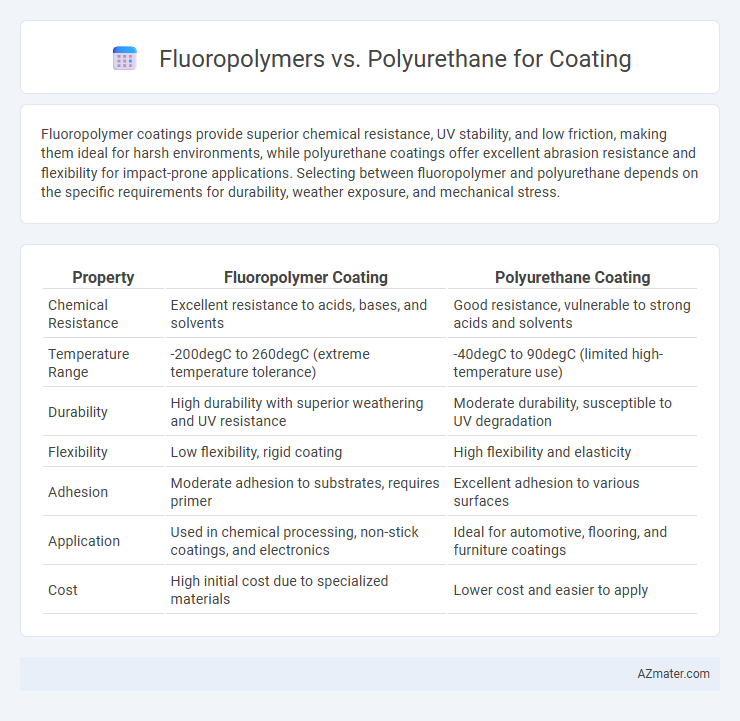Fluoropolymer coatings provide superior chemical resistance, UV stability, and low friction, making them ideal for harsh environments, while polyurethane coatings offer excellent abrasion resistance and flexibility for impact-prone applications. Selecting between fluoropolymer and polyurethane depends on the specific requirements for durability, weather exposure, and mechanical stress.
Table of Comparison
| Property | Fluoropolymer Coating | Polyurethane Coating |
|---|---|---|
| Chemical Resistance | Excellent resistance to acids, bases, and solvents | Good resistance, vulnerable to strong acids and solvents |
| Temperature Range | -200degC to 260degC (extreme temperature tolerance) | -40degC to 90degC (limited high-temperature use) |
| Durability | High durability with superior weathering and UV resistance | Moderate durability, susceptible to UV degradation |
| Flexibility | Low flexibility, rigid coating | High flexibility and elasticity |
| Adhesion | Moderate adhesion to substrates, requires primer | Excellent adhesion to various surfaces |
| Application | Used in chemical processing, non-stick coatings, and electronics | Ideal for automotive, flooring, and furniture coatings |
| Cost | High initial cost due to specialized materials | Lower cost and easier to apply |
Introduction to Fluoropolymer and Polyurethane Coatings
Fluoropolymer coatings, known for their exceptional chemical resistance and low surface energy, provide superior protection against harsh environmental conditions and UV degradation. Polyurethane coatings offer excellent abrasion resistance and flexibility, making them ideal for surfaces subjected to mechanical wear and impact. Both coatings serve distinct industrial applications based on their unique chemical composition and performance characteristics.
Chemical Composition and Structure Differences
Fluoropolymers consist of carbon-fluorine bonds, creating a highly stable and chemically inert structure that offers superior resistance to solvents, acids, and UV radiation. Polyurethane, composed of urethane linkages formed from the reaction of isocyanates and polyols, provides flexibility and abrasion resistance but is more susceptible to chemical degradation and hydrolysis. The molecular structure of fluoropolymers leads to low surface energy and excellent non-stick properties, whereas polyurethane's segmented polymer chains enable enhanced mechanical performance and adhesion to diverse substrates.
Durability and Longevity Comparison
Fluoropolymer coatings exhibit superior chemical resistance, UV stability, and weatherability compared to polyurethane, resulting in exceptional durability and prolonged lifespan in harsh environments. Polyurethane coatings offer good abrasion resistance and flexibility but tend to degrade faster under prolonged UV exposure and harsh chemical conditions. For applications demanding long-term protection with minimal maintenance, fluoropolymer coatings provide a more reliable and lasting solution.
Resistance to Chemicals and Environmental Factors
Fluoropolymer coatings exhibit superior resistance to harsh chemicals, UV radiation, and extreme temperatures, making them ideal for demanding industrial environments. Polyurethane coatings offer good chemical resistance and abrasion protection but tend to degrade faster under prolonged exposure to UV light and aggressive solvents. Choosing fluoropolymers ensures enhanced durability and longevity in environments with strong acids, alkalis, and intense environmental stressors compared to polyurethane alternatives.
Performance in Extreme Temperatures
Fluoropolymer coatings excel in extreme temperatures, maintaining chemical resistance and durability from -200degC to 260degC, making them ideal for harsh environments. Polyurethane coatings perform well up to approximately 80degC but degrade faster under prolonged heat, limiting their use in high-temperature applications. The superior thermal stability and weather resistance of fluoropolymers ensure long-lasting protection where temperature fluctuations are severe.
Application Methods and Ease of Use
Fluoropolymer coatings are commonly applied through spray and electrostatic methods, offering excellent chemical resistance but requiring precise surface preparation and curing conditions, which may increase complexity. Polyurethane coatings provide versatile application options including brushing, rolling, and spraying, known for ease of use and quicker drying times that facilitate faster project completion. The choice between these materials depends heavily on the specific application environment, desired durability, and the skill level of the applicator.
Cost Analysis: Fluoropolymer vs Polyurethane
Fluoropolymer coatings typically have higher upfront costs than polyurethane due to advanced chemical properties and superior durability. Polyurethane offers a more cost-effective initial investment but may require more frequent maintenance and reapplications, increasing long-term expenses. Evaluating the total cost of ownership, including lifespan and performance under environmental stress, is crucial for accurate cost analysis between these coatings.
Typical Industries and Use Cases
Fluoropolymer coatings excel in chemical processing, aerospace, and automotive industries due to their exceptional resistance to solvents, UV radiation, and extreme temperatures. Polyurethane coatings are preferred in construction, furniture, and marine sectors for their flexibility, abrasion resistance, and strong adhesion to various substrates. Both materials serve specialized roles in protective coatings, with fluoropolymers favored for durability and polyurethane chosen for impact resistance and aesthetic finishes.
Maintenance and Recoating Requirements
Fluoropolymer coatings offer superior chemical resistance and UV stability, resulting in extended maintenance intervals and reduced recoating frequency compared to polyurethane coatings. Polyurethane coatings typically require more frequent inspections and recoating every 5-7 years due to their susceptibility to abrasion and environmental degradation. Choosing fluoropolymer coatings can lead to lower long-term maintenance costs and minimized downtime in industrial and architectural applications.
Choosing the Right Coating for Your Project
Fluoropolymer coatings offer exceptional chemical resistance, UV stability, and long-term durability, making them ideal for outdoor and harsh environment applications. Polyurethane coatings provide excellent abrasion resistance, flexibility, and impact protection, suitable for projects requiring toughness and elasticity. Choosing the right coating depends on project specifics such as environmental exposure, mechanical stress, and desired lifespan to ensure optimal performance and cost-efficiency.

Infographic: Fluoropolymer vs Polyurethane for Coating
 azmater.com
azmater.com